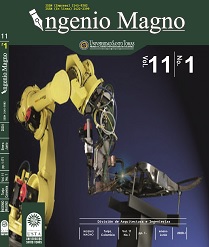Pump irrigation systems for peach crops in the municipality of Sotaquira department of Boyacá
Main Article Content
Abstract
Downloads
Article Details
DECLARATION OF ORGINIALITY OF SUBMITTED ARTICLE
With this document, I/We certify that the article submitted for possible publication in the institutional journal INGENIO MAGNO of the Research Center Alberto Magno CIIAM of the University Santo Tomás, Tunja campus, is entirely of my(our) own writing, and is a product of my(our) direct intellectual contribution to knowledge.
All data and references to completed publications are duly identified with their respective bibliographical entries and in the citations thus highlighted. If any adjustment or correction is needed, I(we) will contact the journal authorities in advance.
Due to that stated above, I(we) declare that the entirety of the submitted material is in accordance with applicable laws regarding intellectual and industrial property, and therefore, I(we) hold myself(ourselves) responsible for any complaint related to it.
If the submitted article is published, I(we) declare that I(we) fully relinquish publishing rights of the article to the University Santo Tomás, Tunja campus. As remuneration for this relinquishment of rights, I(we) declare my(our) agreement to receive two (2) copies of the edition of the journal in which my(our) article appears.
References
Gobernación de Boyacá. Evaluaciones Agropecuarias, 2018
Departamento Nacional de Planeación DNP. (2007-a). Aprovechar las potencialidades del campo: Propuesta para discusión. Colombia: Imprenta Nacional de Colombia, ISBN 978-958-
8340-09-8.
Vermillion, D. L., & Garces-Restrepo, C. (1994). Transfer of irrigation management to farmers in Colombia: Assessment of process and results. Quarterly Journal of International Agriculture, 33(4), 380-392. Retrieved from www.scopus.com
Santos Da Silva, S. R., Miralles-Wilhelm, F., Muñoz-Castillo, R., Clarke, L. E., Braun, C. J., Delgado, A., . . . McJeon, H. C. (2019). The paris pledges and the energy-waterland nexus in Latin America: Exploring implications of greenhouse gas emisión reductions. PLoS ONE, 14(4) doi:10.1371/journal.pone.0215013
Organización de las Naciones Unidas para la alimentación y la agricultura - Fao, Afrontar la escasez de agua Un marco de acción para la agricultura y la
seguridad alimentaria. 2013.
R. G. Allen, L. S. Pereira, D. Raes, and M. Smith, Evapotranspiración del cultivo Guías para la determinación de los requerimientos de agua de los cultivos. 2006.
[8] Organización de las Naciones Unidas para la alimentación y la agricultura - FAO, Afrontar la escasez de agua Un marco de acción para la agricultura y la seguridad alimentaria. 2013.
Ochoa, K., Carrillo, S., & Gutiérrez, L. (2014). Energy efficiency procedures for agricultural machinery used in onion cultivation (Allium fistulosum) as an alternative to reduce carbon emissions under the clean development mechanism at Aquitania (Colombia). Paper presented at the IOP Conference Series: Materials Science and Engineering, , 59(1) doi:10.1088/1757-899X/59/1/012008 Retrieved from www.scopus.com
Quero Virla, Milton (2010). Confiabilidad y coeficiente Alpha de Cronbach. ISSN: 1317-0570. Disponible en: https://www.redalyc.org/articulo.oa?id= 993/99315569010.
Miranda D.; Carranza C. (2013). Caracterización, clasificación y tipificación de los sistemas de producción de caducifolios: ciruelo, duraznero, manzano y peral en zonas productoras de Colombia. En: Miranda, D.; Fischer, G.; Carranza, C. (eds). Los frutales caducifolios en Colombia: Situación actual, sistemas de cultivo y
plan de desarrollo. Soc. Col. Cienc. Hort. p.870-114.
12] Arenas-Bautista, M. C., Vélez-Sánchez, J. E., & Camacho-Tamayo, J. H. (2012). Evaluation of two drip irrigation systems in production and fruit quality of pear (Pyrus communis L.) cv. triunfo de viena. [Acta Agronómica, 61(1), 1-9. Retrieved from www.scopus.com

